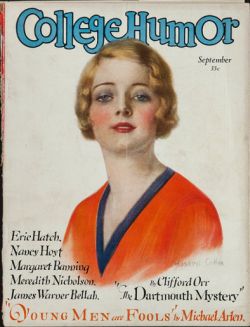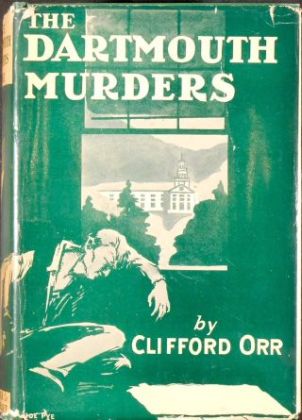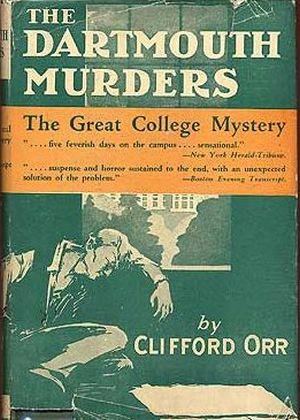 In June 1920, a few minutes after a dispute at a Dartmouth College dorm room, Bob Meads, a sophomore, who sold bootlegged whiskey he sourced from Canada, fatally shot senior, Hank Maroney of the Theta Delta Fraternity. Another Dartmouth College sophomore at the time, Clifford “Kip” Orr, deeply affected by the murder of his classmate, captured the atmosphere of the stunned college campus in a fictional mystery novel, titled The Dartmouth Murders, which was published in 1929. Unlike the true crime event, Orr’s story had imaginary characters and described 3 murders at three different Dartmouth campus locations. The killer was a music professor at the college.
In June 1920, a few minutes after a dispute at a Dartmouth College dorm room, Bob Meads, a sophomore, who sold bootlegged whiskey he sourced from Canada, fatally shot senior, Hank Maroney of the Theta Delta Fraternity. Another Dartmouth College sophomore at the time, Clifford “Kip” Orr, deeply affected by the murder of his classmate, captured the atmosphere of the stunned college campus in a fictional mystery novel, titled The Dartmouth Murders, which was published in 1929. Unlike the true crime event, Orr’s story had imaginary characters and described 3 murders at three different Dartmouth campus locations. The killer was a music professor at the college.
The Dartmouth Murders, first appeared in serial form as The Dartmouth Mystery, in a magazine titled College Humor, Vol.18:2-4 (September-November,1929). The novel was published in book format by Farrar and Rinehart, during the publisher’s inaugural year (New York: Farrar & Rinehart, 1929). It did, in fact, come out on the day of the stock market crash, October 29, 1929. Despite the disclosure on a title page: “All events and all important characters in this story are entirely imaginary,” the image on the dust-jacket with the Dartmouth Hall clock outline, underneath the title The Dartmouth Murders, subconsciously alluded to the 1920 actual murder.
Orr dedicated his book to Franklin McDuffie, class of 1921, in the Dartmouth English Department. The story was copyrighted by the Collegiate World Publishing Company (College Humor). After Franklin McDuffee graduated from Dartmouth, he became an English professor at the College, and soon after that, at the urging of President Ernest Martin Hopkins, class of 1901, wrote the words to the College’s tribute anthem Dartmouth Undying.
The Farrar & Rinehart first edition of the book, featuring Joe Pye’s green art on its dust jacket, and showing the Dartmouth Hall in the background, is quite scarce. It is currently held by several institutions. The Dartmouth College Rauner Special Collections Library, has several copies, some signed by the author, and it also has Orr’s original manuscript. There have not been any sales recorded by our own Rare Books Sales Monitor in recent years, and there are no copies currently available for sale. It is thus quite difficult to provide an estimated on this book’s value.
The reprint edition, published by Grosset and Dunlap, carries an orange band printed on top of the Dartmouth Hall image, with the blurb: “’Absorbing and dramatic mystery and crime.’ – Transcript’ . . . five feverish days on the campus . . . sensational.’ -New York Herald-Tribune’ . . . suspense and horror sustained to the end, with an unexpected solution of the problem.’ -Boston Evening Transcript.” Grosset and Dunlap, historically known for its photoplay editions and juvenile series books, was primarily a hardcover reprint house with large volume circulations. This edition of the book, which has the identical format to the Farrar & Rinehart edition, except of course for the change to the dust-jacket image, is actually available for sale on various marketplaces, for less than $100.
The Dartmouth Murders, was made into a movie in 1935, titled A Shot in the Dark (no more Dartmouth on the title). The New York Times panned the movie version for which Orr wrote the script, with the critic: “an inability to be properly mysterious…..excessively routine…. lead actors subscribe to the wooden Indian school of acting.” The star of the movie, Charles Starrett, was fullback on Dartmouth’s 1925 national championship football team, and was a member of the class of 1926, and thus, a late-comer to the 1920 campus murder scene. He did not share the same feelings that Orr did, nor did he know Meads or Maroney (killer and victim) intimately and lacked a spark of realism. Another famous author to be, who joined the college the year following the murder, was Theodor Seuss Geisel, better known as Dr. Seuss. He, of course, focused on children’s literature and cartoons. What effect life on campus during the murder could have inflicted on the feel good children’s storyteller? One would never know.



{ 1 comment… read it below or add one }
Hi I recently purchased a Clifford Orr, The Dartmouth Murders, Possible first edition from October 1929. It has an inscription on the inside signed Clifford Orr and a date of October 1929, it was also printed by Farrar and Rinehart, The Collegiate World publishing company. It doesn’t have a dust jacket and has slight damage.